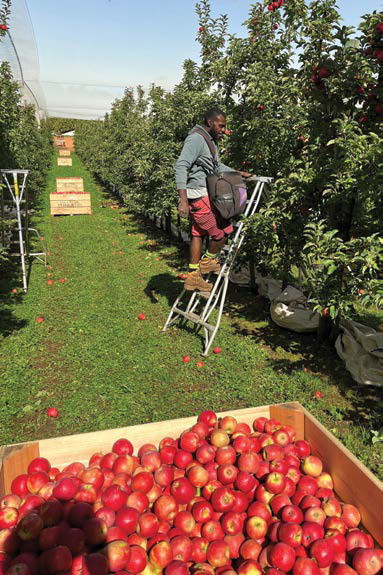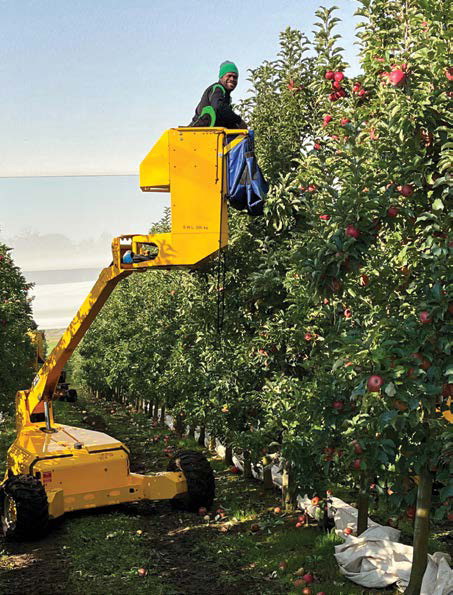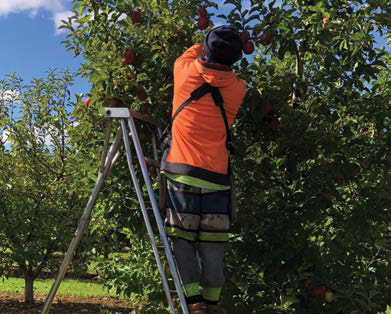
Future Orchards® trial compares different harvest picking systems
Platforms have the potential of keeping costs down and broaden the pool of workers.
HARVESTING from a Revo™ platform.

BY SUSIE MURPHY WHITE PROJECT MANAGER, POMEWEST
Platforms not only broaden the pool of available workers but also have the potential to keep costs down when compared to the traditional bags and ladders picking method.
With increasing costs and reduced availability of harvest labour, the potential for platforms to reduce costs has attracted plenty of interest.
But with a raft of variables ranging from orchard planting systems and terrain to labour demographics all influencing cost and efficiency, it has been near impossible to forecast potential savings with any certainty.
To better understand the cost effectiveness and labour benefits, six Western Australian growers led by Pomewest Project Manager Susie Murphy White tracked costs, picking times and worker demographics of harvesting a block of high colour Pink Lady apples with both platforms and bag and ladders over two years in a Future Orchards®trial, funded by APAL’s Pink Lady business.
Yield, pack-out and cost data, as well as grower surveys were used to compare the different picking methods across blocks varying in size and tree-training systems ranging from vase-shaped to 2D.
Yield, pack-out and cost data, as well as grower surveys were used to compare the different picking methods across blocks varying in size and tree-training systems ranging from vase-shaped to 2D.
Picking systems — Platforms vs Bag and Ladder
In the 2021 season, all but one orchard in the group used a bag and ladder or squirrel for picking (Figure 1). While older style platforms had been in use over many years, the 2022 season saw the introduction of the Revo™ picking platform in WA. The orchards blocks studied varied in their size and tree training systems.
In 2022, trial data shows most orchards used ground crews with ladders or stools, two used the Revo™ picking platforms, two used squirrels, and one an older style platform. No orchard used a platform exclusively.
A varying mix of labour sources — backpackers, locals and Pacific seasonal workers — was used in most orchards, including the two where the platforms were introduced. Number of picks also varied between orchards and seasons.
Cost of picking apples
The lowest cost to pick a bin in 2022 was Orchard F, who employed male Pacific Seasonal Workers using bags and ladders at $43 per bin, closely followed by Orchard A at $44 per bin using platform plus the bag and ladder.

BAG and ladder picking.
Orchard E was the lowest cost per bin in 2021 at $42 per bin with a mix of locals and backpackers picking using bags and ladders achieving an 80% class one pack out.
In all orchards the more picks required resulted in a higher cost to pick the bin with the average cost to pick a bin at $52 for both seasons.
The fastest picking crew were using the bag and ladder system in Orchard F taking an hour per bin, closely followed by Orchards A using the platform along with the ground crew and Orchard E, which were using the bag and ladders at an hour and half.


The most common age range for pickers was the 18–35 age group.
Who was picking apples in 2022
In the 2022 season, many orchards were male dominated with Pacific Seasonal Workers and not many females picking apples. Orchard F employed all male Pacific Seasonal Workers. This was the third year in a row of using Pacific Seasonal Workers, while two other orchards had taken on the Pacific Seasonal Workers for the first time in 2022.
The most common age range for pickers was the 18–35 age group with a few in the next age group 35–55 years. Orchard D employed someone over 55 and another picker under 18.
When planning the study, the expectation was that using a picking platform would improve the age range of pickers that could be employed so that the range of staff was more diverse, and more people would want to do the job.
Growers were asked: Did using a platform change who you could employ?
• Yeah, it was good for our girls, so they didn’t have a bag
• It meant my 70-year-old neighbour could continue to pick fruit in our orchard
• Girls found it easier on the platform
• Ithink using the platform allows for people with a lower fitness level to pick more consistently. In the past we have generally relied on young, strong and fit people to pick our crop, but using the platform definitely allows older workers or people with a lower fitness level to continually pick at a decent rate.
Future picking systems
Most growers had no plans to change their picking systems, with one planning on improving tree structure, controlling vigour to make picking with the platform easier.
Most orchards were planning to invest in Pacific workers through the Pacific Australia Labour Mobility (PALM) program and in new robot-ready planting systems in the future. Only two growers said they planned investment into picking platforms.
The increased number of Pacific seasonal workers in WA orchards has delivered a reduction in the cost per bin, due to the willingness and capacity of the islanders to pick at pace. There is more interest from growers in investing in PALM scheme workers than in platforms.
While the implementation of the picking platform into the pome orchard has opened up who can be employed to pick fruit, the uptake of platforms in WA to date is limited. We are not able to draw strong conclusions as the two platform orchards also used ‘bag and ladders’ to supplement the platform over harvest.
Platforms increase the number of people that can pick fruit as the need to be physically very fit and strong is eliminated.
Unlike a ladder and bag system where each labour unit can be incentivised with a piece rate, platform picking requires the staff to work as a team paid at an hourly rate. The culture and training of the team is critical to ensure individual worker output is optimised.

Picking the tops with a squirrel.

The two orchards in this study that used the new platforms were able to harvest the crop at a lower bin rate than the trial average, which shows that platform picking does have the potential to not only increase the labour demographic, but also keep costs down.
At the time of writing, the packouts for the 2022 crop are unknown. Based on other experience, platforms that are well set up could cause less picking damage than a bag and ladder.
Many growers who use platforms state that the real efficiency gains occur at pruning, training, and thinning times, with harvest being a bonus.
What is unclear is whether there are other workers capable of picking fruit and able to reduce the cost per bin. A more diverse employee demographic in a future season may see the economics swing more in favour of the use of platforms.
MORE INFORMATION
Contact Susie Murphy White, at: susan.murphy-white@dpird.wa.gov.au
